Expert List Climate Change
Part I: What does the future hold for us?
Regional climate models
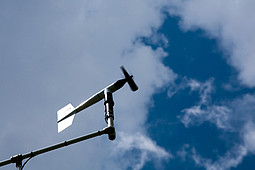
New basic knowledge for better weather and climate prediction: How does climate change directly affect the region? In which areas is it getting much warmer or colder? Where is the rainfall getting heavier? At the Institute of Physics and Meteorology, researchers use unique measurement instruments and refined simulation models to look into regional changes caused by climate change.
Contact: Prof. Dr. Volker Wulfmeyer, Institute of Physics and Meteorology, +49 (0)711 459 22150, email
Preparing for climate change
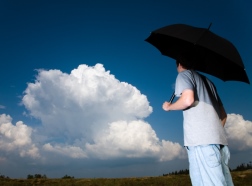
From evaporation to humidity to the creation of clouds and precipitation: The meteorologist and climate scientist Prof. Dr. Volker Wulfmeyer is working on a model that will represent the entire water cycle with all its interdependencies and loops. In doing so, he also simulates extreme events such as long droughts and torrential rainfalls with a new resolution of up to 100m and with a span that covers the entire latitude circle around the world.
It is expected that such events will become more frequent due to climate change. That is why these simulations are linked to models from agriculture, business, and society in order to quantify the effects and minimize damage.
For process studies and the verification of the new generation of weather prediction and climate models, the Institute of Physics and Meteorology developed two 3-dimensional laser remote sensing systems that are unique worldwide. With its new climate and weather simulations, the Institute of Physics and Meteorology is included in international working groups of the World Climate and World Weather Research programs and thus brings expertise to the University of Hohenheim that can otherwise only be found at large research institutions.
Contact: Prof. Dr. Volker Wulfmeyer, Institute of Physics and Meteorology, +49 711 459 22150, E-mail
How Vegetation Influences the Climate
The increase in temperature expected worldwide - combined with more frequent droughts - says little about whether a particular region will become much hotter or maybe even cooler. What is grown on the fields has a big influence on the regional climate - and vice-versa. Plants allow water to evaporate and take in part of the solar energy while emitting part of it, thereby influencing the heat balance, water cycle, cloud formation, wind, and rain. Prof. Dr. Thilo Streck uses computer models to investigate how the soil and vegetation influence the climate and which effects the future climate will have on soil and vegetation.
Contact: Prof. Dr. Thilo Streck Institute of Soil Science and Land Evaluation, Department of Biogeophysics, +49 (0)711 459 22796, E-mail
How does Drought Affect Soil Organisms?
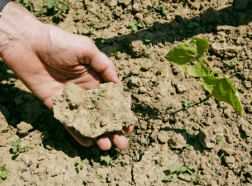
Drought also affects the soil and microorganisms that live in it. The make-up of microbial communities can change - and that has far-reaching consequences for the plants as well as the carbon and nutrient balance. Prof. Dr. Ellen Kandeler looks into these interactions and can answer your questions.
Contact: Prof. Dr. Ellen Kandeler, Department of Soil Biology, +49 (0)711 459 24220, E-mail
Drought and wet conditions change species composition
Water plays an essential role for vegetation and the prevalence of certain species. The landscape ecologist Prof. Dr. Frank Schurr evaluates how plant communities change when drought or flooding occurs, for example in the middle-European grasslands or in South Africa. The research also takes climate change into consideration, which is expected to cause more droughts and extreme weather events in the future.
Contact: Prof. Dr. Frank Schurr, Department of Landscape Ecology and Vegetation Science, +49 711 459 22865, E-mail
Biodiversity and climate change
How do species and ecosystems react to changed climate conditions? Which species might die out, which will benefit? The landscape ecologist Prof. Dr. Frank Schurr looks into the effects of climate change on ecosystems and biodiversity. The focus of his research lies on plant communities, but he also examines animals such as butterflies. Prof. Dr. Schurr has carried out his research in many parts of the world: Besides Central Europe, he has also done field work in North America, around the Mediterranean, in South Africa, and in the Boreal region.
Contact: Prof. Dr. Frank Schurr, Institute of Landscape and Plant Ecology, Department of Landscape Ecology and Vegetation Science, +49 711 459 22865, E-mail
How does weed flora change?
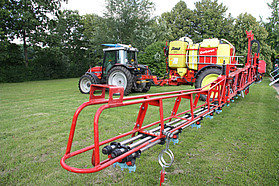
Warm winters give weeds an advantage, as they can grow well thanks to the warm weather. For agriculture, this means additional efforts to fight weeds and greater losses in yields, says Prof. Dr. Roland Gerhards from the Department of Weed Science.
Contact: Prof. Dr. Roland GerhardsInstitute of Phytomedicine, Department of Weed Science, +49 711 459 22399, E-mail
What are climate models good for?
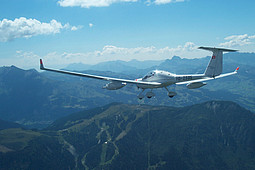
Climate models give useable global prognoses. At the local level, however, there is still a great need for research: Due to climate change, vegetation, agricultural, and human behavior are changing - but how does that affect the weather? And what can politicians, farmers, and other actors do? What grows on which fields? How does the climate differ in valley and hillside areas? How do the new climate conditions affect working conditions, product quality, and farmers’ income?
Prof. Dr. Thomas Berger, Prof. Dr. Thilo Streck, and Prof. Dr. Volker Wulfmeyer are working on a new generation of computer models which unite all research activities at the University of Hohenheim. The spatial preciseness of the models is said to be 3km for Germany. In two model regions - Kraichgau and the Swabian Alb - they can even depict the climate with 1km accuracy.
Contact:
Prof. Dr. Thilo Streck, Department of Biogeophysics, +49 711 459-22796, email
Prof. Dr. Thomas Berger, Department of Land Use Economics, +49 711 459-24116, email
Prof. Prof. Dr. Volker Wulfmeyer, Institute of Physics and Meteorology, +49 711 459-22150, email
PART II: Don't wait, be active
How politics can steer the transformation of agriculture
Agricultural policy must aim to not lose sight of climate protection and food security while at the same time halting the loss of biodiversity. Policies play a central role in addressing the conflicting goals that arise. To ensure that the transformation towards a climate- and biodiversity-friendly land use and food system succeeds, Prof. Dr. Arndt Feuerbacher uses simulation models to understand which measures are goal-promoting and which are rather ineffective – and in the worst case lead to undesirable results.
Contact: Prof. Dr. Arndt Feuerbacher, Department of Ecological-Economic Policy Modeling, +49 711 459-24672, email
Agronomy: What will the cultivation systems of the future look like?
How must cultivation systems be designed for the future? Climate change and drought, as well as the issue of biodiversity or the transformation of nutrition, are a major factor in the field of agronomy today. How can cultivation systems be designed so that they can cope with these challenges? Can old, new, or little-used crops such as legumes or hemp contribute to the solution in this country? How can digitalization in agriculture support this transformation? Prof. Dr. Simone Graeff-Hönninger will be happy to answer these questions.
Contact:Dr. Simone Graeff-Hönninger, Department of Agronomy, +49 711 459-22376, email
How new varieties defy climate change
How can the food supply for the world's population be ensured now and in the future - even under increasingly difficult conditions such as the effects of climate change? Plant breeding has a key role to play here. Prof. Dr. Tobias Würschum explains how modern breeding methods can contribute to this.
Contact: Prof. Dr. Tobias Würschum, Department of Plant Breeding, +49 (0)711 459 23544, email
How do plants react to climate change - and what adaptation strategies are available?
How do plants react to climate change? How does it change ecosystems? And how can we predict these changes? Plant ecologist Jun.-Prof. Dr. Andreas Schweiger studies responses to environmental changes. From this, he draws conclusions as to which adaptation strategies can be targeted for more sustainable land use in the future.
Contact: Jun.-Prof. Dr. Andreas Schweiger, Department of Plant Ecology, +49 711 459-22189, email
Climate, economy, and society - what are the conflicting goals?
How do we make a transition to a sustainable, bio-based economy that will slow down and be resilient to climate change while minimizing negative economic and social impacts? A successful transformation is only possible if you get the support of as many people as possible. Therefore, when it comes to protecting the environment and the climate, one cannot ignore business and society. The economist Prof. Dr. Franziska Schünemann analyzes possible conflicting goals and explains how to deal with them.
Contact: Prof. Dr. Franziska Schünemann, Department of Bioeconomy, +49 711 459 24500, email
Innovative foods - how can they successfully enter the market?
How can new, innovative products gain a foothold in the food sector? Alternative protein sources or meat substitutes, for example, that are designed to reduce climate-damaging meat production? Prof. Dr. Stefan Hirsch from the Department of Management in Agribusiness explains the drivers of demand for products and what is important for them to succeed in the market.
Contact: Prof. Dr. Stefan Hirsch, Department of Management in Agribusiness, +49 (0)722 459 24740, email
Smart irrigation of urban trees
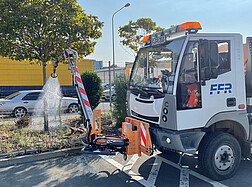
Urban trees in most cities are watered on a rigid schedule with a fixed amount of water. The consequences: some trees die from lack of water, others receive more water than necessary. Here, an intelligent irrigation system could provide relief and conserve resources with demand-based irrigation. Prof. Dr. Henner Gimpel and Dr. Valerie Graf-Drasch from the Department of Digital Management are exploring the possibilities of this technology.
Contact:
Prof. Dr. Henner Gimpel, Department of Digital Management, +49 711 459 24051, email
Dr. Valerie Graf-Drasch, Department of Digital Management, +49 711 459 24051, email
Big Data: Digital Agriculture Offers Assistance in Adapting to Droughts
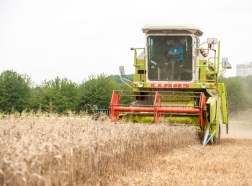
Agricultures across the world now need to react to more frequently occurring drought periods. For example, they need to choose other types of crops or adapt the way they manage the land. But which decisions are the right ones? Digital agriculture can help farmers in the search for good adaptation strategies. The key is to link very large amounts of data with the land surfaces and actors.
Prof. Dr. Thomas Berger and Prof. Dr. Thilo Streck are developing computer models to simulate the consequences of possible decisions - including using new types of crops and management methods. Prof. Prof. Dr. Regina Birner is looking into the ways in which agricultural innovation systems can react more effectively to climate change and droughts, and how the potential of digital innovation can be used for this.
Contact:
Prof. Dr. Thomas Berger, Department of Land Use Economics in the Tropics and Subtropics, +49 (0)711 459 24116, E-mail
Prof. Dr. Thilo Streck, Institute of Soil Science and Land Evaluation, Department of Biogeophysics, +49 (0)711 459 22796, E-mail
Prof. Dr. Regina Birner, Department of Social and Institutional Change in Agricultural Development, +49 (0)711 459 23517, E-mail
What effects plants’ stress tolerance?
Stress from dryness and salt - two factors than can seriously hinter crop growth. Prof. Dr. Sandra Schmöckel investigates how these kinds of extremes affect plants and what their stress tolerance depends on. She focuses in particular on: barley and the superfood quinoa.
Contact: Prof. Dr. Sandra Schmöckel, Department of Physiology of Yield Stability, +49 711 459 23806, email
Crop production under water scarcity
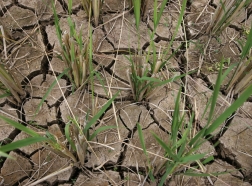
Drought and unfertile soils often occur together. That is also the case in Africa's sub-Saharan Sahel region. Breeding scientist apl. Prof. Dr. Bettina Haussmann works with crops that are especially important for small farmers under these harsh conditions: sorghum and pearl millet. Her new working group develops strategies for the efficient breeding of new types of millet that are easy to grow and yield good and stable harvests even on unfertile soils and in times of drought.
Contact: apl. Prof Dr. Bettina Haussmann, Department of Plant Breeding, +49 711 459 23484, E-mail
How can Plants Handle Stress from Drought Better?
Drought also stresses plants. Across the globe, this is a serious problem for farmers. Prof. Dr. Christian Zörb researches the physiological mechanisms of plant adaptation to drought stress. Particularly sensitive crops such as corn or wheat are the focus of his work. In addition, he analyzes the effects of abiotic stress on the quality of these plants’ yields as well as a few other important crops such as grapes, tomatoes, or onions.
Contact: Prof. Dr. Christian Zörb, Institute of Crop Science, Dept. Quality of Plant Products, +49 (0)711 459 22520, E-mail
Breeding Informatics for Rye and Triticale with Better Resistance to Drought Stress
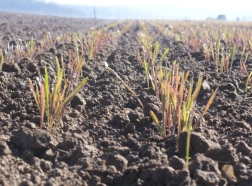
Rye and triticale do not place high demands on the weather or soil conditions. Still, drought periods can quickly become a problem for them since they are cultivated in regions that are already dry. Entire harvests can be lost. For breeding improved tolerance to drought stress, it is essential to know the extent of genetic variability of rye and triticale.
The bioinformaticians and breeding researchers apl. Prof. Dr. Thomas Miedaner, Prof. Dr. Hans-Peter Piepho, and Prof. Dr. Karl Schmid want to use new statistical methods and improved breeding materials to accelerate the breeding selection and minimize genetic impoverishment so that faster reactions to environmental changes are possible.
Contact:
apl. Prof. Dr. Thomas Miedaner, State Plant Breeding Institute - Rye Department, +49(0)711 459 22690E-mail
Prof. Dr. Hans Peter-Piepho, Institute of Crop Science, Department of Biostatistics, +49 (0)711 459 22386, E-mail
Prof. Dr. Karl Schmid, Department of Crop Biodiversity and Breeding Informatics, +49 (0)711 459 23487E-mail
Artificial intelligence for resilient production systems
As climate change progresses, the framework conditions for agriculture are constantly changing. What can artificial intelligence do to help address this? Is digital agriculture fit for the future? Does it make production systems more sustainable and resilient? How can intelligent agricultural engineering systems progressively adapt to changing environmental and general conditions through continuous learning? Jun.-Prof. Dr. Anthony Stein answers your questions on the topic.
Contact: Jun.-Prof. Dr. Anthony Stein, Department of Artificial Intelligence in Agricultural Engineering, +49 711 459 22532, email
Irrigation management in developing countries
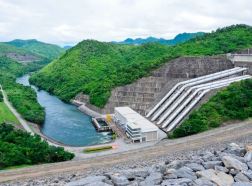
The agricultural economist Prof. Dr. Regina Birner examines institutional and political challenges for irrigation management in developing countries. Her research areas include:
- Governance problems in state irrigation projects, for example building small dams in Ghana or larger irrigation facilities in India (e.g. political influence, mismanagement of funding),
- effects of national irrigation policies on the use of resources, e..g subsidies for using groundwater for irrigation, which could lead to overuse in the case of India.
The researcher’s focus also lies on concrete reform measures that are intended to counteract the problems: For example the transfer of the management of irrigation systems to local water usage associations.
Contact: Prof. Dr. Regina Birner, Department of Social and Institutional Change in Agricultural Development, +49 711 459 23517, E-mail
Optimal water use securing good harvests
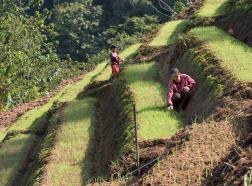
How can farmers in the tropics and subtropics make optimal use of water, that is, in ecologically sustainable and profitable ways? The agricultural scientists and biologist Prof. Dr. Folkard Asch explores this question in multiple projects:
- Rice production: Rice is one of the most water-intensive crops and at the same time the basic food for more than one-third of mankind. Prof. Dr. Asch investigates the effect of reduced irrigation on the yield of various rice varieties to derive recommendations for new growing systems.
- Rubber plantations in Southeastern China: The scientist studies the water circulation in the plantations to help the operators make less use of water in the future and thereby protect the vulnerable ecoystem.
- Jatropha: This oil-producing plant, which may also be grown in regions with seasonal drought, could be an alternative source of bioenergy in the future and at the same time provide people in rural areas with additional income. It is unclear, however, whether large-scale production of Jatropha really makes sense ecologically and economically. Prof. Dr. Asch investigates how much water the plant needs and how efficiently that water is used for oil production.
Contact: Prof. Dr. Folkard Asch, Department of Water Stress Management in Crops in the Tropics and Subtropics, +49 711 459 22764, E-mail
Economic irrigation technology
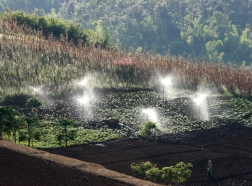
In dry regions, the soils often become over-salinated when farmers artificially irrigate their fields. This does not have to be the case, however. The agricultural engineer Prof. Dr. Joachim Müller is developing a new procedure in which the salt is washed out of the soil using drainage systems, and the drainage water is used for irrigating salt-tolerant crops.
Prof. Dr. Müller is also developing special sensors to ensure that wasting water is kept at a minimum. These sensors are to determine how dry the soil is and how much suction a plant needs to get water. Farmers can then turn the irrigation system on or off depending on need. Highly sensitive sensors that are placed on roots and leaves also have the purpose of measuring whether or not a plant needs water.
Together with his staff, the expert has also developed the so-called deficit irrigation. With this technique, fruit trees receive less water than they could evaporate at certain times. The result: With the targeted drought stress, the trees reduce growth on their crowns and invest their resources in their fruit.
Contact: Prof. Dr. Joachim Müller, Department of Agricultural Engineering in the Tropics and Subtropics, +49 711 459 22490, E-mail
Genetic and Molecular Background for Drought Tolerance in Plants
To avoid drought damage, plants can reduce their water and maximize water intake through their roots. Root growth and its importance for the intake of water and nutrients is the research concentration of Prof. Dr. Waltraud Schulze and Prof. Dr. Uwe Ludewig. They also research how transport processes, e.g. water and nutrient intake, are regulated.
Contact:
Prof. Dr. Waltraud Schulze, Department of Plant Systems Biology, +49 (0)711 459 24770, E-mail
Prof. Dr. Uwe Ludewig, Department of Nutritional Physiology of Cultivated Plants, +49 (0)711 459 22344, E-mail
Planting trees against desertification
Brazil’s northeastern regions are being threatened by desertification because trees are being cleared for firewood and wood charcoal and surfaces are being used too intensively for grazing. The agricultural economist Dr. Jörn Germer is attempting to counteract this development. The approach: Certain useful, native types of trees are to be reproduced in order to provide for alternative income possibilities for the local population.
In doing so, the researcher aims to consciously avoid artificial irrigation. As an alternative, he plants the seedlings in a plant-nutrient enriched mix of natural sandy soil, goat dung, and clay soil which can hold rainwater for a particularly long time. In addition, a special vegetable coal ensures that the nutrients are slower to be washed out.
Contact: Dr. Jörn Germer, Department of Agricultural Ecology in the Tropics and Subtropics, +49 711 459 23505, E-mail
Trace gas transport from agricultural soils
Agriculturally used soils transport climate-relevant trace gases. Nitrous oxide (laughing gas), for example, is a much stronger greenhouse gas than carbon dioxide and is also responsible for ozone depletion in the stratosphere. Among others, it is generated during the use of nitrogen fertilizers. How relevant is this for climate change? What does the transport of this gas depend on, and how can we influence it? Can the carbon footprint of biofuels made out of rapeseed be improved if trace gas emissions are taken note of? Dr. Reiner Ruser is an expert in this area and will gladly answer your questions.
Contact: Prof. Dr. Reiner Ruser, Department of Fertilisation and Soil Chemistry, +49 711 459 23291, E-mail
Methane - Ruminants and their greenhouse gases
The greenhouse gas methane is a major contributor to climate change. One important source: burping ruminants. How relevant are these emissions coming out of the stomachs of cattle, sheep, and goats? How are they generated? How can animal nutrition contribute to improve the situation? Prof. Dr. Markus Rodehutscord, Department of Animal Nutrition at the University of Hohenheim, is researching these issues and will be happy to answer your questions.
Contact: Prof. Dr. Markus Rodehutscord, Department of Animal Nutrition, +49 711 459 22420, E-mail
Engineering for change
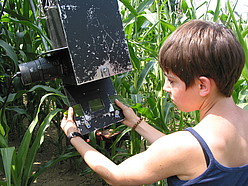
Basic research alone is not enough: Using simple, adapted techniques that also work for developing countries, agricultural engineers at the University of Hohenheim develop adapted solutions in order to slow the change: Solar drying to conserve fruit, oil cookers which work with any kind of vegetable oil, energy from woodchips. A second research concentration is devoted to techniques to meet the rising need for water for the population in a world in which desertification is spreading.
Contact: Prof. Dr. Joachim Müller, Department of Agricultural Engineering in the Tropics and Subtropics, +49 711 459 22490, E-mail
Climate protection in the root zone
Does climate change increase or decrease the carbon balance in the soil? Professors Dr. Georg Cadisch and Dr. Torsten Müller are looking into this question. It has been shown: An increased plant production, in particular increased root activity, enriches the soils with additional carbon. But the expected higher air temperature has precisely the opposite effect. Do the two processes balance each other out or does one outweigh the other? And which effects does the respective CO2 feedback have on the climate?
Contact: Prof. Dr. Georg Cadisch, Department of Agricultural Engineering in the Tropics and Subtropics, +49 711 459 22438, E-mail
How do plants deal with water?
In agriculture and ecology, one question is fundamental if we want to respond to climate change: How do plants deal with water? The ecophysiologist Prof. Dr. Martin Bouda investigates plant networks - using real, digital and fossil plants. He focuses in particular on plant roots and integrating plant function across scales. With his research, he also wants to contribute to countering climate change: with improved prediction models and better understanding of the evolution of drought resistance in plants.
Contact: Jun.-Prof. Dr. Martin Bouda, Department of Functional Plant Ecophysiology, +49 711 459 23922, E-mail
Insurance policies against the consequences of climate change

Drought, torrential rain, and storms cause increasing damage all over the globe. Can insurance policies reduce the consequences for the individual? What does the situation look like in Germany? Would a statutory insurance help? Do developing countries even have a market for these insurances? Can microinsurance help? Feel free to discuss these questions with Prof. Dr. Jörg Schiller, an expert for the insurance business.
Contact: Prof. Dr. Jörg Schiller, Department of Insurance and Economics and Social Systems, +49 711 459 22869, E-mail
To use water in the most efficient way
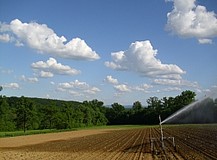
Irrigation, electricity, fish farming, or simply quenching your thirst: Humans use water for all kinds of purposes. This may easily lead to conflicts, especially because clean water is an increasingly scarce resource. That is why agricultural economist Prof. Dr. Thomas Berger explores ways of managing this resource. It is not always clear at first glance what type of water use is the most efficient and best for the environment.
What is the best economic use: a hydroelectric power station or the artificial irrigation of fields? Are there possible compromises? And what are the effects on the environment? Frequently it is easily possible to use the same water multiple times for different purposes. Another question is: Where can farmers save water by using it more efficiently and employing modern technology?
Contact: Prof. Dr. Thomas Berger, Department of Land Use Economics, +49 711 459-24116, email
How plants absorb and emit water
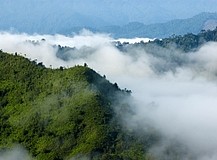
The entire world is made up of spheres. Two of those are the atmosphere (air) and the pedosphere (soil). Water is present to a high degree in both of these. But how do the two spheres exchange water? This is the question which the biogeophysicist Prof. Dr. Thilo Streck is pursuing. Plants play an important role in this. They absorb water from the ground and it evaporates from their leaves. Through this, they then influence the forming of precipitation. In addition, the researcher is evaluating how pesticides and other environmental chemicals spread. What path do they take from the field soils to the ground and surface water?
Contact: Prof. Dr. Thilo Streck, Institute of Soil Science and Land Evaluation, Department of Biogeophysics, +49 711 459 22796, E-mail
Press releases
Agroforst in viticulture:
Trees strengthen vines – with the same wine quality [09.09.2025]
Vines in the shade of trees: So-called Vitiforst systems can significantly improve the water supply and nutrient availability for the vines – without changing the quality of the wine. Researchers at the Universities of Hohenheim and Freiburg have reached this conclusion together with multiple wine-growing families in Ayl (Rhineland-Palatinate). Since 2007, the team has been...more
Excellence Strategy:
University of Hohenheim scores highly in the awarding of Clusters of Excellence [22.05.2025]
Participation in two Clusters of Excellence: This is the University of Hohenheim’s assessment at today’s announcement of the results of the Excellence Strategy of the federal and state governments. “GreenRobust” is a joint cluster with the universities of Tübingen and Heidelberg. It is dedicated to the question of how plants can remain functional despite environmental stress...more
Wind energy:
Misinformation about wind farms is widespread [21.10.2024]
Wind turbines are harmful to health and economically inefficient - such misinformation undermines the social acceptance of wind turbines. However, they are widespread and meet with great approval: over a quarter of respondents in representative studies involving the University of Hohenheim in Stuttgart agree with a variety of misinformation. This mainly depends on the...more
Climage change:
Tree rings record unprecedented air dryness [27.12.2023]
The atmosphere across Europe has become markedly drier in recent decades compared to pre-industrial times due to greenhouse gas emissions. This is reported by an international tree-ring study led by the Swiss Federal Institute for Forest, Snow and Landscape Research WSL. A drier atmosphere may exacerbate droughts and wildfire risk with consequences for forests and agriculture....more
Climate Research:
New DFG research group at the University of Hohenheim [14.12.2023]
Whether one looks at long-term climate forecasts or the prediction of storms, drought, and heavy rainfall – the interaction between land and atmosphere plays a major role. The German Research Foundation (DFG) is setting up the “Land-Atmosphere Feedback Initiative (LAFI)” research group on this topic at the University of Hohenheim in Stuttgart. The DFG research group’s...more
EUR 2.6 million in REACT-EU recovery assistance:
New imaging device network advances research [21.04.2023]
The cliché that a picture often says more than 1,000 words holds true for research: A new pool of equipment at the University of Hohenheim in Stuttgart delivers high-resolution three-dimensional visualization of the objects under investigation. Another special feature: The devices can be linked together – so you can view the same detail at different scale levels. On 20 April...more
Innovative fertilization methods:
Fewer emissions from slurry fertilization in growing field crops [14.12.2021]
Up to 55 percent less ammonia emissions thanks to innovative methods: Commercial fertilizers such as slurry or digestate from biogas plants could be spread on fields and meadows in a much more environmentally friendly way. This was demonstrated by the initial results of a collaborative project involving the University of Hohenheim in Stuttgart. The project has set its sights...more







